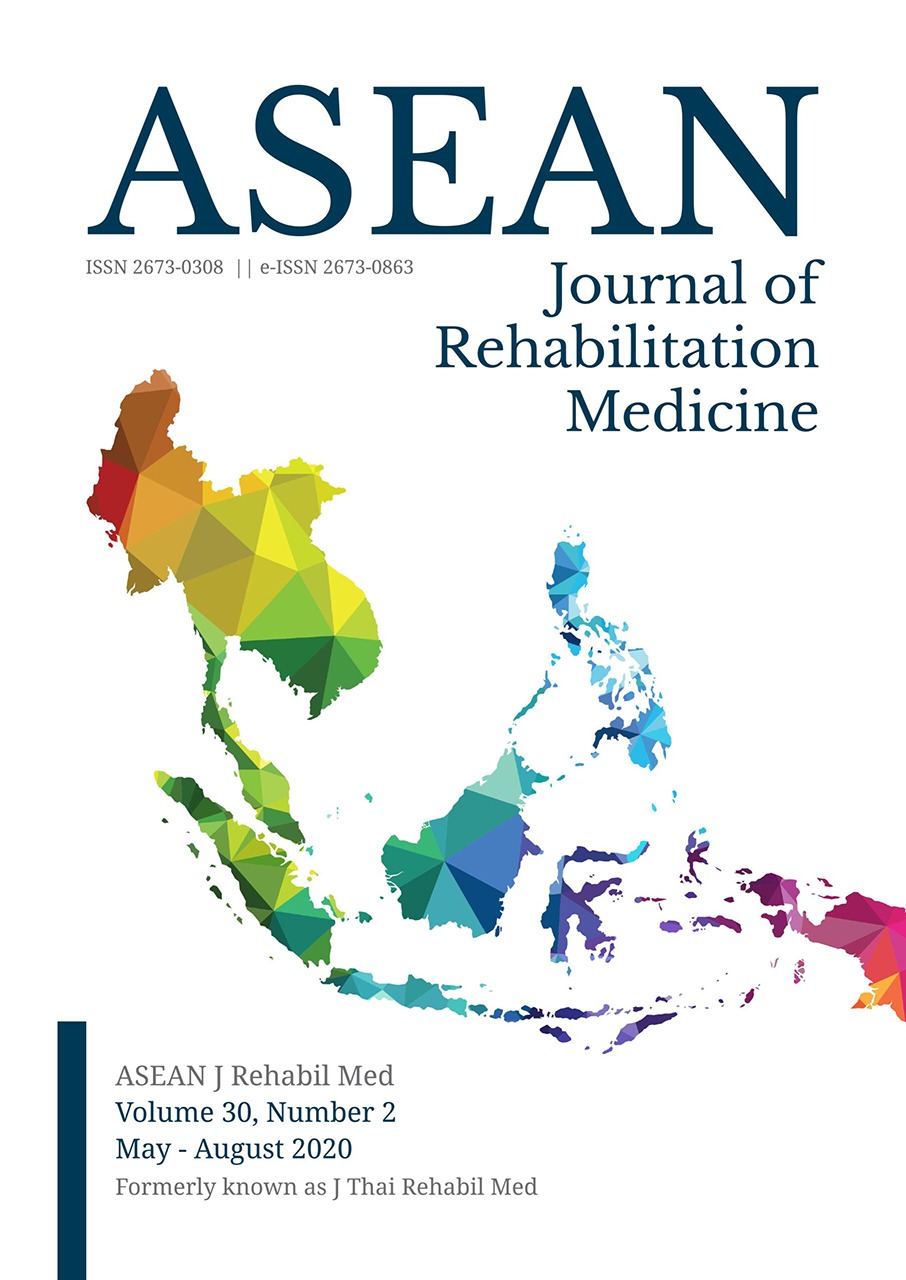Efficacy of Sedentary Time Reduction with Mobile Texting and Focused Educational Sessions in Patients with Coronary Artery Disease: a Randomized Controlled Trial
Keywords:
behavior, patient education, cardiac rehabilitation, physical activity, coronary artery diseaseAbstract
Objectives: To assess the efficacy of mobile texting and focused educational session on sedentary behavior in patients suffering from coronary artery disease.
Study design: Randomized controlled trial.
Setting: Cardiac Rehabilitation Clinic, Rehabilitation Medicine Department, Faculty of Medicine, Ramathibodi Hospital, Mahidol University, Bangkok, Thailand.
Subjects: Patients with coronary artery disease who underwent cardiac rehabilitation program from November 2018 to May 2020 at Ramathibodi Cardiac Rehabilitation Clinic.
Methods: The participants were randomized to receive either a standard cardiac rehabilitation (control group), or a standard cardiac rehabilitation with mobile texting and focused educational sessions on sedentary behavior (intervention group). Seden-tary time and time spent in other physical activity levels were recorded at baseline, 1, 3, and 6 months following participation in both groups. This was done using the Thai short International Physical Activity Questionnaire (Thai short IPAQ). The effects of mobile texting and focused educational sessions on sedentary behavior were analyzed by employing a mixed effects linear regression analysis.
Results: Participants spent about 13.72 hours/day engaging in sedentary behavior. The intervention group showed significantly less prevalence of diabetes compared with the control group. This baseline difference was adjusted in the regression model. The between-group comparison study found that sedentary time was significantly less at 3 months in the intervention group compared with the control group (at 3 months; difference 1.75 hour/day, p = 0.002). Mild intensity physical activity rose signi-ficantly only at the end of the study (at 6 months; difference 1.00 hour/day, p = 0.047). There was no significant difference between the two groups at all follow-up intervals for moderate-to-vigorous physical activity.
Conclusion: Additional mobile texting and focused educational sessions on sedentary behavior to a standard cardiac rehabilitation program, helped the patients with coronary artery disease reduce their sedentary time at 3 months.
References
Young DR, Hivert MF, Alhassan S, Camhi SM, Ferguson JF, Katzmarzyk PT, et al. Sedentary behavior and cardiovascular morbidity and mortality: ascience advisory from the American Heart Association. Circulation. 2016;134:262-79.
Chau JY, Grunseit AC, Chey T, Stamatakis E, Brown WJ, Matthews CE, et al. Daily sitting time and all-cause mortality: a meta-analysis. PLoS One. 2013;8(11):e80000.
American Association of Cardiovascular & Pulmonary Rehabilitation. Guidelines for cardiac rehabilitation and secondary prevention programs. 5th ed. Champaign: Human Kinetics; 2013.
Biswas A, Oh PI, Faulkner GE, Alter DA. A prospective study examining the influence of cardiac rehabilitation on the sedentary time of highly sedentary, physically inactive patients. Ann Phys Rehabil Med. 2018;61:207-14.
Ter Hoeve N, Sunamura M, van Geffen ME, Fanchamps MH, Horemans HL, Bussmann JB, et al. Changes in physical activity and sedentary behavior during cardiac rehabilitation. Arch Phys Med Rehabil. 2017;98:2378-84.
Ribeiro F, Oliveira NL, Silva G, Campos L, Miranda F, Teixeira M, et al. Exercise-based cardiac rehabilitation increases daily physical activity of patients following myocardial infarction: subanalysis of two randomised controlled trials. Physiotherapy. 2017;103:59-65.
Ramadi A, Buijs DM, Threlfall TG, Aggarwal SG, Arena R, Rodgers WM, et al. Long-term physical activity behavior after completion of traditional versus fast-track cardiac rehabilitation: J Cardiovasc Nurs. 2016;31:E1-7.
Biswas A, Faulkner GE, Oh PI, Alter DA. Patient and practitioner perspectives on reducing sedentary behavior at an exercise-based cardiac rehabilitation program. Disabil Rehabil. 2017;6:1-8.
Evenson KR, Butler EN, Rosamond WD. Prevalence of physical activity and sedentary behavior among adults with cardiovascular disease in the United States: J Cardiopulm Rehabil Prev. 2014;34:406-19.
Rattanawiwatpong P, Khunphasee A, Pongurgsorn C, Intarakamhang P. Validity and reliability of the Thai version of short format International Physical Activity Questionnaire (IPAQ). J Thai Rehabil Med. 2006;16:147-60.
Armanasco AA, Miller YD, Fjeldsoe BS, Marshall AL. Preventive health behavior change text message interventions: a meta-analysis. Am J Prev Med. 2017;52:391-402.
Thakkar J, Redfern J, Thiagalingam A, Chow CK. Patterns, predictors and effects of texting intervention on physical activity in CHD – insights from the TEXT ME randomized clinical trial. Eur J Prev Cardiol. 2016;23:1894–902.
Nigg CR. ACSM’s behavioral aspects of physical activity and exercise. Philadelphia: Lippincott Williams & Wilkins; 2014.
Patrick K, Raab F, Adams MA, et al. A text message-based intervention for weight loss: randomized controlled trial. J Med Internet Res. 2009;11(1):e1. doi:10.2196/jmir.1100.
Free C, Knight R, Robertson S, Whittaker R, Edwards P, Zhou W, et al. Smoking cessation support delivered via mobile phone text messaging (txt2stop): a single-blind, randomised trial. Lancet. 2011;378:49-55.
Jonas S, Phillips EM. ACSM’s exercise is medicine: a clinician’s guide to exercise prescription. Philadelphia: Lippincott Williams & Wilkins; 2009.
Abraham C, Michie S. A taxonomy of behavior change techniques used in interventions. Health Psychol. 2008;27:379-87.
Murtagh EM, Murphy MH, Foster C, Milton K, Roberts NW, O’Gorman CS. Interventions outside the workplace for reducing sedentary behaviour in adults under 60. Cochrane Public Health Group, editor. Cochrane Database Syst Rev [Internet]. 2017. [cited 2018 Jun 7]. Available from: http://doi.wiley.com/10.1002/ 14651858.CD012554
Chastin S, Gardiner PA, Ashe MC, Harvey JA, Leask CF, Balogun S, et al. Interventions for reducing sedentary behaviour in community-dwelling older adults. Cochrane Public Health Group, editor. Cochrane Database Syst Rev [Internet]. 2017. [cited 2018 Jun 7]. Available from: http://doi.wiley.com/10.1002/14651858.CD012784
Khamput T, Puangkrampun M, Sangsamritpol W, Thongbo T, Seunglee S, Keryai T, et al. Thailand recommendations on physical activity, non-sedentary lifestyles and sleeping for office-based employee. Bangkok: Division of Physical Activity and Health, Department of Health, Ministry of Public Health; 2017.
Khamput T, Puangkrampun M, Sangsamritpol W, Thongbo T, Seunglee S, Keryai T, et al. Thailand recommendations on physical activity, non-sedentary lifestyles and sleeping for elderly (age 60 years and over). Bangkok: Division of Physical Activity and Health, Department of Health, Ministry of Public Health; 2017.
Kwasnicka D, Dombrowski SU, White M, Sniehotta F. Theoretical explanations for maintenance of behaviour change: a systematic review of behaviour theories. Health Psychol Rev. 2016;10:277-96.
Buijs DM, Ramadi A, MacDonald K, Lightfoot R, Senaratne M, Haennel RG. Quantity and quality of daily physical activity in older cardiac patients. Can J Cardiovasc Nurs. 2015;25:10-6.






